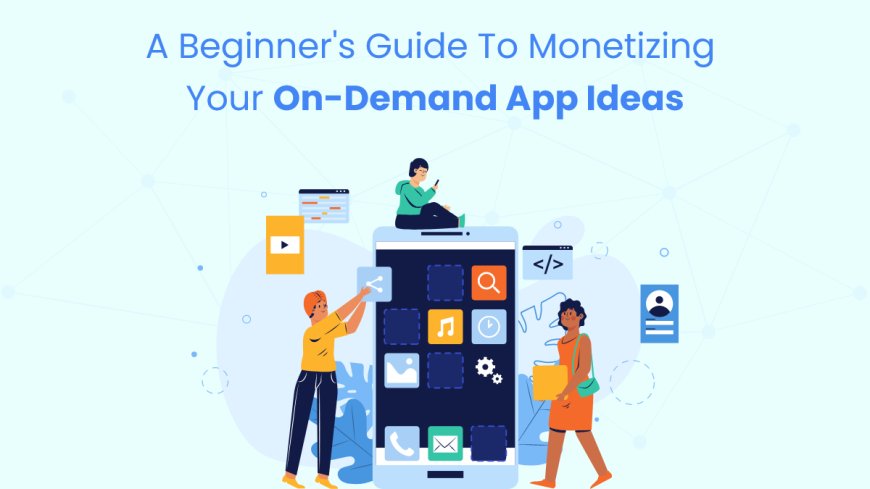A Beginner's Guide to Monetizing Your On-Demand App Ideas
Unlock the potential of your on-demand app ideas with our beginner's guide to monetization. Explore strategies for revenue generation, including in-app purchases, subscriptions, ads, and partnerships, and learn how to effectively implement them for financial success and growth.

The on-demand economy has exploded, transforming industries from transportation to food delivery with convenience and instant gratification. If you’re a developer or entrepreneur with an innovative on-demand app idea, monetization is a crucial step in turning your concept into a profitable venture. This guide will walk you through various strategies to effectively monetize your on-demand app and turn it into a revenue-generating asset.
1. Understand Your Market and Audience
Before choosing a monetization strategy, it's essential to have a deep understanding of your target market and audience. Your app’s success hinges on how well you address their needs and preferences. Conduct thorough market research to identify potential users' pain points, spending habits, and the value they place on your app's offerings.
Market Research Tips:
-
Survey Potential Users: Gather insights on what users are willing to pay for and their preferred payment models.
-
Analyze Competitors: Study how similar apps in your niche monetize their services and evaluate their effectiveness.
-
Identify User Segments: Determine different user segments and their specific needs to tailor your monetization approach.
2. Choose the Right Monetization Model
There are several monetization models to consider for your on-demand app, each with its own advantages and challenges. The choice depends on your app’s nature, target audience, and market dynamics.
Popular Monetization Models:
-
Freemium Model: Offer a basic version of your app for free and charge for premium features or content. This model works well for apps where additional features can enhance user experience, such as advanced analytics or exclusive content.
-
Pros: Attracts a large user base with the free offering.
-
Cons: Requires a compelling value proposition for premium features.
-
Subscription Model: Users pay a recurring fee to access your app’s services. This model is suitable for apps offering continuous value, such as content streaming or regular service access.
-
Pros: Provides predictable revenue and can build customer loyalty.
-
Cons: Requires ongoing delivery of value to justify recurring payments.
-
Pay-Per-Use Model: Charge users based on their usage of the app. This model is ideal for services like ride-sharing or on-demand delivery, where users pay for each transaction.
-
Pros: Users pay only for what they use, which can be attractive for occasional users.
-
Cons: Revenue can be unpredictable and dependent on user activity levels.
-
Advertisement Model: Generate revenue by displaying ads within your app. This model is effective for apps with high user engagement and large user bases.
-
Pros: Can be lucrative if you have a high volume of active users.
-
Cons: Ads can detract from user experience if not implemented thoughtfully.
-
Commission-Based Model: Charge a commission on transactions facilitated through your app. This model works well for platforms connecting buyers and sellers, such as marketplace apps.
-
Pros: Scales with transaction volume and can be highly profitable.
-
Cons: Requires a robust platform to handle transactions securely.
3. Implement In-App Purchases
In-app purchases (IAPs) are a popular way to monetize on-demand apps by allowing users to buy virtual goods, upgrades, or additional features directly within the app. IAPs can enhance user experience and drive additional revenue without requiring users to leave the app.
IAP Strategies:
-
Offer Consumables: Sell items that are used up over time, such as virtual currency or tokens.
-
Provide Non-Consumables: Offer permanent upgrades or content, such as ad-free experiences or exclusive features.
-
Create Subscriptions: Offer premium features or content on a recurring basis.
4. Build Partnerships and Sponsorships
Forming strategic partnerships and securing sponsorships can provide additional revenue streams for your on-demand app. Collaborate with other businesses or brands to offer integrated services, co-branded features, or exclusive deals.
Partnership Ideas:
-
Cross-Promotions: Partner with complementary apps or services to offer joint promotions or bundled deals.
-
Sponsored Content: Allow brands to sponsor content or features within your app.
-
Affiliate Marketing: Promote third-party products or services within your app and earn a commission on sales.
5. Focus on User Retention and Engagement
To maximize monetization, prioritize user retention and engagement. Engaged users are more likely to make purchases, subscribe to premium services, or interact with ads. Implement features and strategies that keep users coming back and spending more time on your app.
Retention Strategies:
-
Personalize Experience: Use data to offer tailored recommendations and experiences.
-
Engage Users: Implement push notifications, in-app messages, and loyalty programs to keep users engaged.
-
Regular Updates: Continuously improve and update your app to maintain user interest and satisfaction.
Conclusion
Monetizing your on-demand app ideas involves understanding your market, selecting the right monetization model, and focusing on user engagement. By choosing the appropriate strategies and continuously adapting to user needs and market trends, you can turn your app into a profitable venture. Remember, successful monetization is not just about generating revenue but also about delivering ongoing value to your users. With the right approach, you can build a sustainable and thriving on-demand app business.

 smithjoe
smithjoe 










